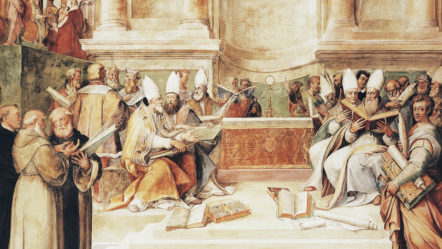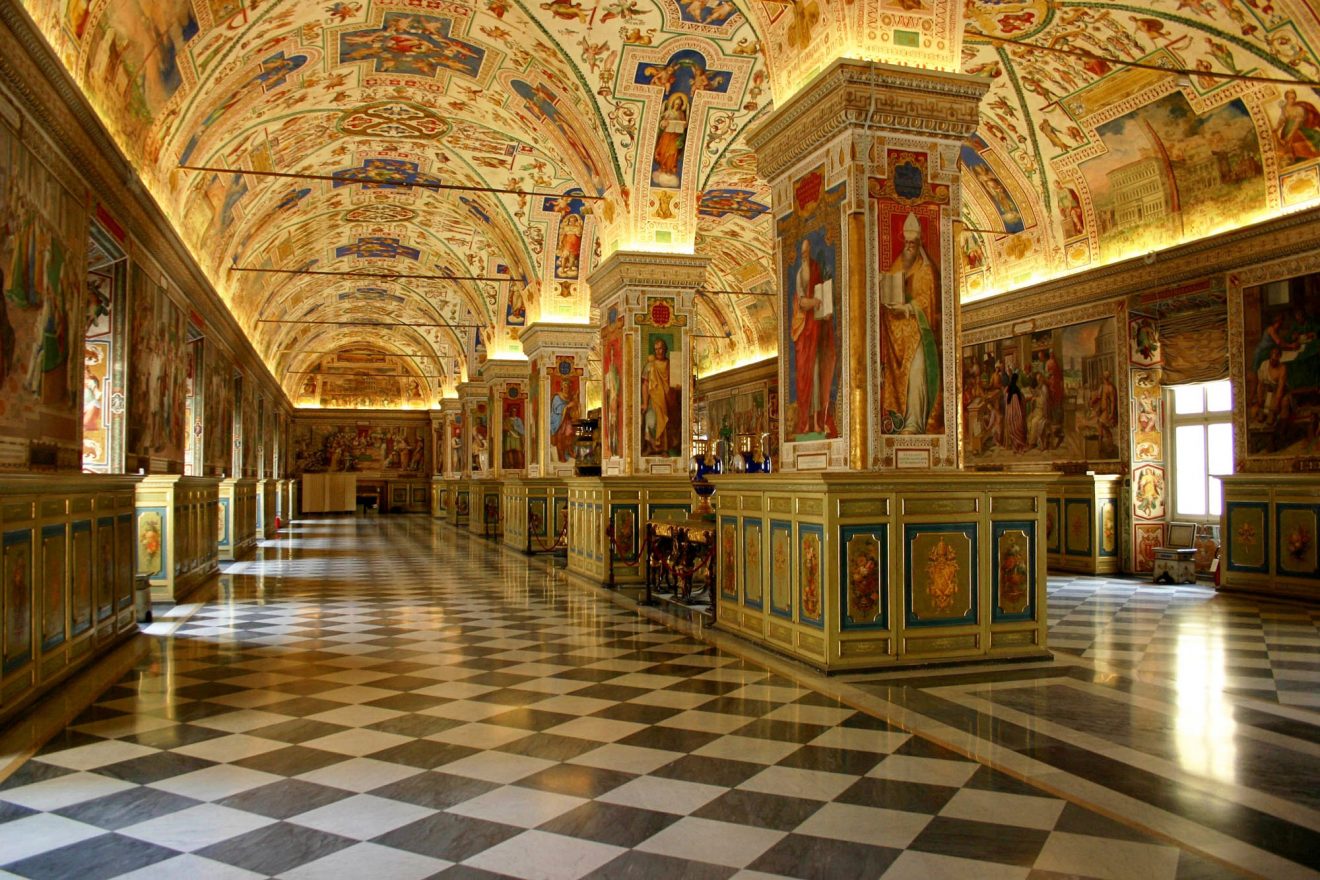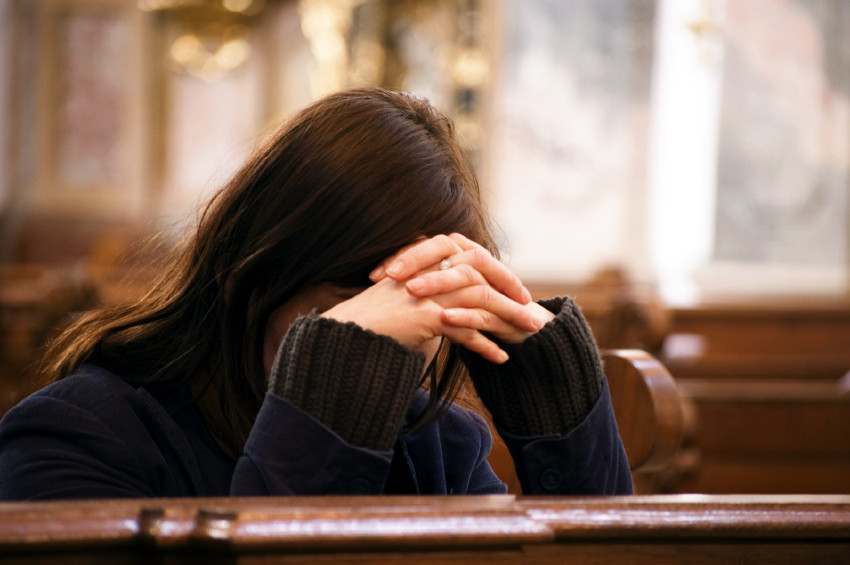Whether called the Counter-Reformation, Catholic Reformation, Confessional Catholicism, Tridentine Age, or any other designation, Catholicism in Europe from 1517-1577 has been analyzed, debated, and subjectively branded throughout history. For many, outdated terminology like Counter-Reformation still remains the predominant vernacular especially when used to describe the reforms occurring within the Catholic Church during this timeframe. This is in spite of some iconoclastic work by scholars like Hubert Jedin, Jean Delumeau, H. Outram Evennett, Ernst Walter Zeeden, John O’Malley, and Heinz Schilling, among others. Taking a closer look at how historians came to label this era as well as the larger nearly 250-year historiography can shed light on how we have come to understand our own modern conception of the “Counter-Reformation” or perhaps what the era should be called, Early Modern Catholicism (EMC).
Johann Stephan Putter was one of the first historians to coin the term “Counter-Reformation” in the mid-18th century to describe what he saw as centrally an anti-Reformational movement. From here on, the Counter-Reformation became something that was forced upon the Church from the outside. Little thought was given to the inner workings of the Catholic Church itself or the ecclesiastical reforms that were already underway. Yet, Putter’s thesis became the central line of thinking for the next two hundred years. And Putter was not alone. This idea gained support a century later when another more well-renowned German historian Leopold Van Ranke made many of the same points in his The Popes of Rome, Their Church and State in the Sixteenth and Seventeenth Centuries.
Just a few years later, Jacob Burckhardt published his seminal work The Civilization of the Renaissance in Italy. In it, he put forth the idea that modernity began during the Renaissance in Italy. Made explicit in his work was the idea that the move toward “modernity” was a positive and that the Catholic church was largely repressive to modernizing agents. Implicitly, it painted the Counter-Reformation as backward defending a corrupt relic of the medieval ages.
Building off of Burckhardt and much more influential was Max Weber’s The Protestant Work Ethic and the Spirit of Capitalism which came in the early 20th century. While not a direct attack on Catholicism, Weber believed the essence of modern socioeconomics or much of what was redeemable about his contemporary society could be found in Protestant values stemming from the Reformation. An emphasis on individualism, frugality, working hard, and being called by God to a secular vocation all played a role, according to Weber, in developing the modern Capitalist system. Again, Protestantism was, if not a positive, at least a nod to the modern world while Catholicism was believed to be a leftover from a bygone era, and this was where EMC stood at the start of the 20th century. This is also where it all began to change.
One of the earliest was the German historian Ludwig von Pastor in the early 20th century who was one the first to access the Vatican archives for his multivolume History of the Popes which acted as a counterweight to Leopold Von Ranke’s aforementioned scholarship. Pastor argued that the efforts for Catholic reform predated the Reformation and that Counter-Reformation ought to be thought of as the Catholic Restoration. There was also H. Outram Evennett who as early as 1930 believed Counter-Reformation did little justice for all that was occurring during EMC, but more will be said on Evennett later. However, it would be Hubert Jedin who would break from the historiographical trend in a clear and transformative way and create a new foundation for studying the period.
His four-volume work History of the Council of Trent which took him three decades to complete is still the go-to work for any student of Trent or EMC. Like Pastor, he believed that Catholicism was undergoing internal pressure to reform long before the Protestant Reformation was underway but conveyed it more unambiguously and diligently. This self-driven precursor to the rise of Protestantism was the Catholic, not Counter-Reformation. It was different from the strain put on Catholic ecclesiastical institutions and rulers due to the schism brought on by Protestantism but also hard to differentiate entirely from it. Thus, Jedin believed this latter description was better defined as the Counter-Reformation. Intrinsic to these ideas is the word reform, not only ecclesiastical but political, social, and cultural that was unfolding during the early modern era in Europe. This new conceptualization would become central to how many future scholars would understand just what was happening not only to Catholicism but become central to understanding the whole of Christianity. Indeed, many if not all Jedin’s conclusions are still foundational for grappling with the intricacies within EMC. However, as a church historian, Jedin tended to focus on large ideas and institutional changes. This left room for the next generation of historians to look at the social (a look from below), spiritual, and many other aspects of the EMC.
Evennett was one of these academics who were able to look at the Catholic Reformation as defined by Jedin but delve deeper into the spiritual side of what was happening and better expound on the interaction of the ecclesiastical with the secular. He brought more attention to the Jesuits, unlike Jedin who focused on Trent. He also made other insightful observations that would go on to shape future historiography, one being that the Protestant and Catholic Reformations were more alike than they were different. This then made the term Counter-Reformation antagonistic to truly understand EMC and the larger period. From here forward scholars delved deeper into the nuances of EMC looking at unifying aspects and focusing less on reframing a total understanding of the era as completed by Jedin. Thus, the argument over the label for the era fell silent until relatively recently.
Two apt examples of scholars who pointed to unifying factors are John Bossy and Ernest Walker Zeeden. Bossy concentrated on the social and cultural importance of Christianity and Catholicism, i.e., the practice of religion. Bossy, especially in his Christianity in the West, 1400-1700, accomplished the tasks of studying religious practices and demonstrating how Christianity as a whole underwent a series of transformations in this period. This was building on some of the early ideas that Evennett first put out describing the innate similarities between the two reformations. Running parallel in the historiography of Bossy and others was Zeeden’s idea of confessionalization in his Konfessionsbildung. Much like the recently mentioned scholars, in the 1950s Zeeden came up with a thesis that united the era rather than divided it between Protestant and Catholic reforms. Zeeden believed that to best understand the time is to dig into the ways the churches built confessional statements over many decades. This meant he and others who followed this methodology looked at the way all Christian churches became distinct institutions with their own doctrines, institutions, and cultural norms.
Utilizing Zeeden’s thesis, some took a more localized approach to confession building. Trevor Johnson, Marc Foster, and David Gentilcore all zero in on specific areas and how confessionalization played out in specific regions of Europe. What they walked away with was a better understanding of just how different this process played out in each place whether it be southern Italy, Upper Palatinate, or rural Germany. Their works all brought a better understanding of how confessionalization was not always a top-down process, and it did indeed differ according to local populations, cultures, and social structures, but was a commonality across diverging denominations.
The most recent trends are both a continuation of many of the recent ideas just mentioned, but also a deeper look into specific differences found among people groups, cultures, and geographic regions. R. Po-Chia Hsia has looked more closely at the ways EMC has interacted with non-Christian cultures including Asia and the Americas in The World of Catholic Renewal. Others like Simone Laqua-O’Donnell and her 2014 work Women and the Counter-Reformation in Early Modern Munster, as well as Barbara Diefendorf and Elizabeth Rapley, have brought a greater understanding of the impact of women on EMC and not just as passive participants, but active members within Catholicism creating dynamic religious communities throughout Europe. And most importantly, it would be remiss to not mention John O’Malley whose ideas I have heavily relied upon and whose term (EMC) I have utilized throughout this essay. Combining Jedin’s work with others O’Malley (Trent and All That) argued for the all-encompassing term Early Modern Catholicism, rather than many of the other narrower labels mentioned earlier. EMC incorporates Catholic reforms prior to the Reformation and reactions stemming from it, as well as leaving an open fluidity to chronological, social, political, cultural, and ecclesiastical contextualization’s not included in many other terms. Also, by using the “early modern” phrase O’Malley squarely places the events correctly in the larger context of early modern Europe, pointing to the importance of viewing what was occurring through the lens of the early modern period and the changing dynamics taking place concurrently.
Indeed, the shared understanding of EMC has gone through not only a plethora of different names but a distinct change in the way scholars interact with and understand the era. Starting from being a purely reactionary measure that was backward moving, to an area of study that showed nuanced ways in which one showcased the modernizing state-building efforts through a variety of reforms and social disciplining, EMC has and continues to be a vibrant area of study. Counter-Reformation is not only an anachronistic term that has long since been refuted but one that does little justice to the complexity of the timeframe. Yet, the future of EMC is anyone’s guess. There will no doubt continue to be a greater look into those not seen as vital to the confessionalization effort (women, native populations, children, servants, etc.) and how they impacted social cohesion. Also, I would imagine there would continue to be an interest in local studies to point out the differences and similarities while also spreading further and further into the periphery (eastern Asia, mid-Africa, and all through the Americas). The future scholarship of EMC is filled with possibilities, but by making sure we use the most historically appropriate verbiage and titles when addressing the issues associated with the time frame, we could also bring greater understanding to it.
+++
SOURCES
Bireley, Robert. The Refashioning of Catholicism, 1450-1700: A Reassessment of the Counter-Reformation. Washington D.C.: Catholic University of America Press, 1999.
Bossy, John. Christianity in the West, 1400-1700. Oxford and New York: Oxford University Press, 1985.
Burckhardt, Jacob. The Civilization of the Renaissance in Italy. New York: Harper Brothers, 1958.
Delumeau, Jean. Catholicism between Luther and Voltaire: A New View of the Counter-Reformation. London: Burns and Oates, 1977.
Diefendorf, Barbara B. From Penitence to Charity: Pious Women and the Catholic Reformation in Paris. New York: Oxford University Press, 2004.
Evennett, H. Outram. The Spirit of the Counter-Reformation. Notre Dame: University of Notre Dame Press, 1970.
_______.The Spirit of the Counter-Reformation: The Birkbeck Lectures in Ecclesiastical History given in the University of Cambridge in May 1951, edited by John Bossy. Cambridge: Cambridge University Press, 1968.
Foster, Marc R., “With and Without Confessionalism in German Catholicism.”Infinite Boundaries: Order, Disorder, and Reorder in Modern German Culture. Kirksville, MO: Sixteenth Century Journal Publishers.
Genrilcore, David. “Methods and Approaches in the Social History of the Counter-Reformation Italy.” Social History 17 (1992), 73-98.
Gregory, Brad. The Unintended Reformation. Cambridge: Harvard University Press, 2015.
Hsia, R. Po-chia. Social Discipline in the Reformation: Central Europe, 1550-1750. London and New York: Routledge, 1989.
_______. The World of Catholic Renewal,1540-1770. Cambridge: Cambridge University Press, 1998.
Jedin, Hubert. History of the Council of Trent. (4 vols.) B. Herder Book Company, 1949-1979.
_______. Katholische Reformation oder Gegenreformation? Ein Versuch zur Klarung der Begriffe nebst einer Jubilaumsbetrachtung uber das Trienter Konzil. Luzern: Verlag Josef Stocker, 1946.
Jedin, Hubert and John Dolan eds., The History of the Church Vol. 5: Reformation and Counter-Reformation. New York, 1980.
Laqua-O’Donnell. Women and the Counter Reformation in Early Modern Munster. Oxford: Oxford University Press, 2014.
Luebke, David M ed. The Counter-Reformation: The Essential Readings. Malden, Massachusetts: Blackwell Publishers Inc., 1999.
MacCulloch, Diarmaid. The Reformation. New York: Viking, 2004.
McGrath, Alister. The Intellectual Origins of the European Reformation. Oxford, Blackwell, 2004.
Mullett, Michael A. The Catholic Reformation. London and New York: Routledge, 1999.
O’Malley, John. Trent and All That. Renaming Catholicism in the Early Modern Era, 2000
Ozment, Steven E. The Reformation in the Cities: The Appeal of Protestantism to Sixteenth-Century Germany and Switzerland. New Haven: Yale University Press, 1975.
Pastor, Ludwig von. History of the Popes: From the Close of the Middle Ages. Trans. Fredrick Ignatius Antrobus er al., 40 vols. St. Louis: Herder, 1891-1953.
Pettegree, Andrew. Reformation and the Culture of Persuasion. Cambridge: Cambridge University Press, 2005.
Putter, Johann Stephan. Die Augsburgische confession. Gottingen: Wittwe Vandenhoeck, 1776.
Reinhard, Wolfgang. “Reformation, Counter-Reformation, and the Early Modern State: A Reassessment.” Catholic Historical Review 75 (1989), 383-404.
Schilling, Heinz. “The Reformation and the Rise of the Early Modern State.” In Luther and the Modern State in Germany, ed. James D. Tracy, 21-30. Kirksville: Sixteenth Century Publishers, 1986.
_______. Religion, Political Culture, and the Emergence of Early Modern Society: Essays in German and Dutch History. Leiden: E. J. Brill, 1992.
Tracy, James. Europe’s Reformations, 1450-1650. Lanham: Rowman and Littlefield, 1999.
Weber, Max. The Protestant Work Ethic and the Spirit of Capitalism. George Allen & Unwin Ltd., 1930. Zeeden, Ernst Walter. Die Entstehung de Konfessionen. Munich: R. Oldenbourg, 1965.







